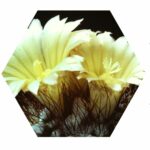Victor “Ray” Titterington, Part 3: Solitary Trees Grow Strong
30 May 2021

This is the third in a three part series about the life and times of Ray Titterington who, in January 2020, bequeathed his entire estate to the Nova Scotia Nature Trust. People from all over the world were captivated by the photos of his fanciful carvings, home, and greenhouse full of cacti. Many wondered about Ray’s past and what had inspired him. Over the past year, two volunteers have gathered the story of Ray’s life, and the gift that will build a wonderful natural legacy. His life story is being shared in a three part series. You can find the first two parts of Ray’s story here–Part 1: A Life Well Lived and Part 2: Imagination Embraces the World—and read the conclusion here.
East Coast Adventure and the Merigoroun House: 1989-2020 (61-92 years old)
Ray lived to build and create. By the late 1980’s, his Easy street home in Baltimore, Ontario was complete and too big without Florie. His imaginative, artistic mind needed another project. Life in southern Ontario was fast paced and noisier than he wanted. Properties with new homes were springing up all around him, and he needed a change.
As part of that desired change, Ray began searching for potential oceanfront properties in 1989. He began his search in Nova Scotia in the Shelburne-Liverpool area. Later that same year, he travelled across the northern US states to Vancouver Island. We aren’t sure, but he may very well have looked for land out there as well. Ray wanted to live by the ocean, and we think that the remoteness, slower pace, and lower real estate prices ultimately drew him to the East Coast. The property at Tilley’s Head in Port L’Hebert would come to offer Ray peace and quiet, and definitely fit the bill as a remote setting.
Ray’s design for the Nova Scotia home was his most unique thus far, and was tailored to meet his specific requirements of having room for his many varied passions. One of those passions was his growing fascination with clowns and circus carousels, which culminated in him becoming a Circus Model Builders member in November of 1989.

In order to pursue this passion, the first design requirement for his new home was that it have a workshop. He also needed room for his prized cactus and succulent collection, which meant he needed a greenhouse. Since he loved the hexagon details of his Easy Street home, he used that same design feature for creating the north-facing workshop and the south-facing greenhouse in Nova Scotia. To fill in the space between the two ends, he designed an open concept bedroom and his living room. With an open floor plan like this, his bedroom was not just for sleeping—it ended up being a cross between a gallery of his wooden creations (both large and small) and a library of his many cherished books, as well as the more common utilitarian place for him to sleep and store his clothes.
The rest of the house was fairly minimal in nature, with a small bathroom. The kitchen deserves special mention. Now on his own in Nova Scotia, Ray certainly did not want all of the traditional trappings of a modern kitchen. He planned his hexagon kitchen more as a space for storing books and to display his hand-made model ships and toys. He only left a few cupboards and drawers for the usual dishes and cooking utensils. The only appliances in the kitchen were the fridge, a microwave on a shelf and a small toaster oven stored inside a cabinet. When one Port L’Hebert neighbour commented on the esthetic of the kitchen and “that it was not designed for a woman since there is no cook top or oven”, Ray very quickly replied that his kitchen was designed solely for him, and he did not need any of those other appliances, nor did he need a woman thank you very much. When he wanted tea or soup, he would simply use a small propane camp stove he had out in his workshop. For him, it worked perfectly well.
Ray built his Merigoroun (Ray’s spelling) house over 10 years. The development of his property began in 1990, when he contracted for a 500 meter driveway to be cleared, and for the excavation and pouring of his foundation. He did all of the framing and roofing himself, with some help at crucial junctures from neighbours, and once again contracted for the electrical work in 1991.
Planning and preparation principles learned early in his life were honed to perfection by the time Ray moved to Nova Scotia. He kept track of his timeline for construction, costs, and planned future projects with precision. His ingenuity was demonstrated during the drywall phase of the Merigoroun home. During the winter of 1990/91, at his home in Baltimore Ontario, he constructed a drywall hanging device from plans. This device allowed him to raise 4 by 8 foot sheets of drywall up to the ceiling so that he could screw them into place on his own. We cannot help but admire his tenacity and ability to find ways to do things by himself.
When you look at the photos of Ray doing the brick work in 1995, keep in mind that he was 67 years old, and did most of the work himself! He moved tons of bricks, moved sand and water into the cement mixer, wheel-barrowed the concrete around the outside of the walls, climbed staging that he had to build, and then he did all of the masonry as well. Once again, we are amazed at his ingenuity, workmanship and work effort.
Ray did not live in Nova Scotia full-time as he was developing the property. Instead, each summer he would come to Nova Scotia with his trusty 1979 Toyota Celica GT hatchback sports car, pulling a little utility trailer with tools, in order to work on his new place. We think he camped on-site initially, perhaps in a camper. As the building process continued, he was gradually able to move inside and live within the house while completing the outside brickwork.
The last phase of the house build was the hexagon shaped greenhouse. When it was completed in 1997, he listed his house for sale in Baltimore, Ontario, and had movers bring his remaining furniture, tools and cacti to Nova Scotia. The moving company was shocked by how remote his home was, and held his belongings as ransom for more money before they would deliver them.
While building in Nova Scotia, Ray continued to be frugal and live within his means. He paid for the build of his Port L’Hebert home as he went, and completed the project using cash. We surmise that he never had a mortgage or car loan in his life. By building in phases, he could ration his cash-flow, and do most of the work alone. Being able to do most of the work himself paid off handsomely for Ray.
The completion of the garage in 1999 capped the 10 year building portion of the project. It was time to celebrate. Ray may have been frugal in many ways, but that didn’t mean that he never treated himself to something shiny and new, which he absolutely did when he bought himself a brand new silver 2001 Toyota Celica GT. This would be his last sports car, and he would keep this car for the remainder of his life. One of his neighbours shared a funny story about this car with us. He said that when Ray was in Liverpool outside of a Tim Hortons one day, some teenagers asked him how an old fellow like him could afford a sports car like that. Ray’s response: “I earned it, I wanted it, so I bought it!”
Life in Port L’Hebert
Ray lived a life of quiet solitude, carving out time to pursue all of the passions he had in his later years. Even though he was getting older, Ray didn’t really slow down. He actively looked after his greenhouse cacti and succulents throughout all four seasons. He tended to the pond just outside the greenhouse doors in the summer, with its resident frogs. He also continued to create wooden masterpieces, in the carousel theme or using the artisanal method for making wooden bowls.
In his downtime he would read. From the books he surrounded himself with, he must have been a voracious reader; however, he would not read just anything. His library was all non-fiction with an emphasis on history, geography, and biographies. He also had many books on aviation, carving, and gardening, with a focus on cacti and succulents of course. As a life-long learner, if he needed to make or know something, he would simply reference a book.
Ray’s favourite spots to sit within the house were in the workshop, the corner of the living room by the window looking into the greenhouse, or in the greenhouse itself. Being in his greenhouse must have reminded him of his desert travels, with its warmth and beauty, including the gift offered by the rare flowerings of his plants. Outside would find him either by his workshop door, the pond, or more likely on his homemade Adirondack chair by the ocean, looking east across the Atlantic to England.
From one of Ray’s friends, we learned that he would hibernate for the winter in the Merigoroun. He never bothered to clear snow from his 500 metre driveway. With his two oil tanks full in his garage, and his freezer and cupboards full of food, he would quite happily spend the winter woodworking, or reading in his greenhouse. Ray had electricity to back up his oil furnace, and hot water baseboard heat for the greenhouse. As an interesting aside, we think he only had hot water in the winter. He really only needed it for the plants in the greenhouse. Once the weather got warmer, and the plants no longer needed the heat, he would turn off the furnace, and with it, the hot water. It appears that he took cold showers the other three seasons to stay tough, and perhaps to save a few pennies as well.
Although he did not travel much during this time, he still ventured out to see local airshows. He also did limited travelling around Nova Scotia, including touring Annapolis Royal and Digby. Otherwise, as far as we can tell, he pretty much stayed on his beautiful property.
Ray was strong and healthy up to age 89, when he suffered a heart attack. Following his heart attack, his neighbours had to convince him to get a phone, which he had not had prior to this. For some reason, he did not care for phone companies, but his neighbours prevailed.
Ray enjoyed people who were like-minded and creative but did not suffer fools gladly. He had a few good friends in Port L’Hebert who he would join on walks to Johnstone Beach. Others he would visit in order to watch history documentaries, and/or partake in the occasional supper. These friends were very protective of Ray, and certainly respected his desire for privacy.
Ray was comfortable and content in his solitude, and there is no doubt in our minds that he would have easily weathered the COVID19 pandemic and need for social distancing.
Ray was a unique man. He was creative and skilled and used his imagination to the fullest. Although sometimes grumpy and prickly like his cactus, his few close friends appreciated him, and were happy to spend time with him.
Friends remember Ray as a quiet, creative man, who was very comfortable with his own company. Those who knew him didn’t think of him as being lonely, but rather content in his self-imposed solitude. He was a genius at creating and building things with his hands, most of which he learned from reading and doing. His imagination was his mentor, and his carvings and cacti were his friends. He loved nature and the world of travel. As for people, they were accepted into his inner circle by invitation only.
Although he may have chosen to spend most of his time alone, he stayed up-to-date on the world outside. While he had no desire for a phone or a computer, he remained well-informed through his radio which was consistently tuned to CBC.
We surmise that Ray heard about the Nova Scotia Nature Trust from his exposure to CBC and local news. With no family to leave his estate to, it only seemed natural for him to leave his greatest possessions, his ‘children’ as it were (home, garden, pond and carousel animal carvings) to an organization that would make the most of his legacy.
There is no question that Ray lived the life he wanted, on his own terms, all while being creative almost every day of his life. His was a life well lived.
We really wish that we had had a chance to meet him. This winter of research and digitizing all of his photos has enlightened and intrigued us. We are left feeling thankful knowing that Ray’s legacy lives on with Nature.
With thanks to everyone who contributed to this story of Ray—Dave and Seely Alder.
Solitary trees, if they grow at all, grow strong. —Winston Churchill
A hexagonal homage
A Tour Through the Estate (Photo credit: Len Wagg)
If you enjoyed this three-part series, you can order a beautifully designed booklet version of the complete story of Ray’s life! Visit the Nature Shop to order your electronic copy.












































































































